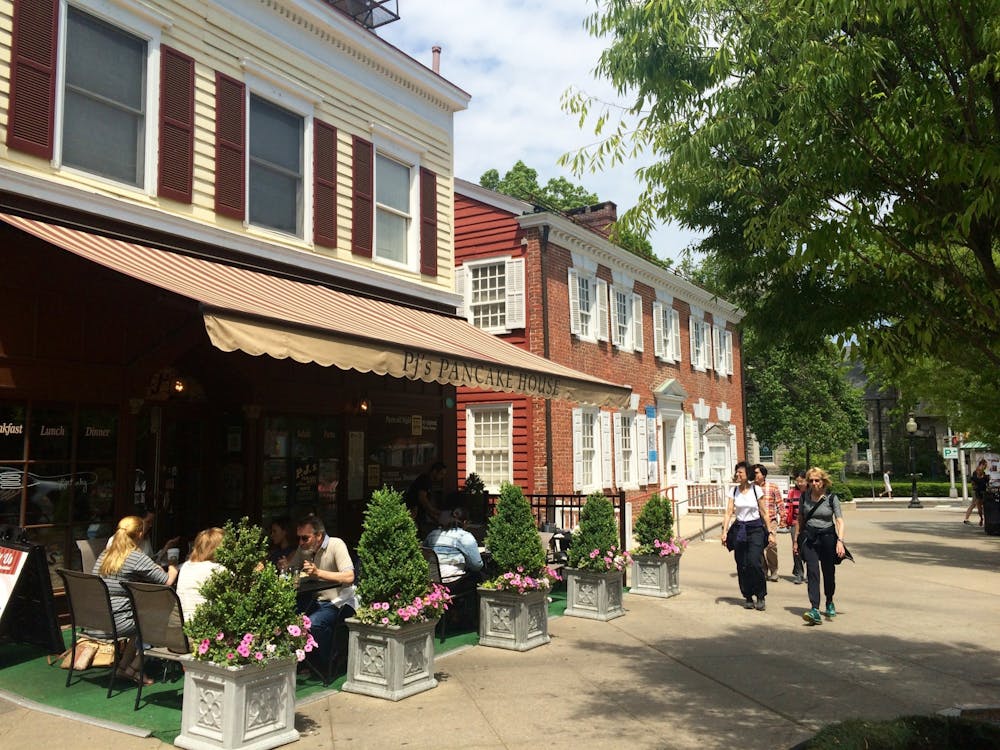I feel as though I just took a quick trip through time. Taking in the Art Museum's newest exhibitions — "Empire of Stone" and "Camera Women" — has left me with a deeper understanding and appreciation for my world and the artistic heroes of the past few thousand years.
Beady eyes peer out from all directions, complimenting stares of confidence and grimaces of pain, curly locks of hardened stone and smooth faces of make-up. The contrast between the two exhibits, linked to one another by a simple doorway, is remarkable. Yet, the feeling that I had coming away from the two was one overwhelming sense of admiration for both the ancient sculptors of Antioch-on-the-Orontes and the silent female snapshot-ers of the past two centuries.
I began my exploration in the farthest corner of the Art Museum, slowly moving my way past the bright colors of the modern artists through the doorway of the "Empire of Stone" exhibit and into its dark confines.
Immediately, I was struck by the contrast between the 48 white and yellow marble sculptures that littered the room and the black paneled walls that surrounded them. The faces and torsos and demons and gods all seemed to spring up from the floor to shine through the room's gloomy confines, an effect created through curator Craig Konyk's creative lighting and installation.
Slowly, as I crept closer to the sculptures, they became increasingly distinct and lifelike. The Roman-Egyptian female coffin mask, with sunken eyes and dimpled chin, looked directly into my eyes, slowly bringing me back to it's owner's tomb. To the right lay brown Syrian stone carvings that were half crumbled and distorted, reminding me of the thousands of years that had elapsed since their creation. A delicate male torso, made of smooth, dully-glimmering marble, looked real, as if it had been constructed on-top of its subject. Rising from the center of the exhibit was the largest piece, a sculptor of a man in armor (all but his head, that is), ready to slay me down, his gigantic presence only helping to enforce the overwhelming sense of history that surrounded me.
Each piece had a story, a life of creation, admiration and, ultimately, destruction. At the exhibit's core were pieces discovered by former professor Howard Crosby Butler in excavations in southern Turkey. His team brought back remnants from a time of sculptural brilliance and innovation, a period in which busts were created as portraits and gods were depicted as super-human figures cast in stone.
Indeed, perhaps the most memorable part of the exhibit was the row of heads that line the exhibit's southwest wall. Women and men peer out of skulls, which are slightly larger than life, yet are portrayed with extreme realism. Marcus Aurelius sits with curly serpent-like hair, peering out with a look of dominance and order. Augustus' feathery mane accompanies a handsome, chiseled face. As I stood cheek to cheek with the great figures of Roman lore, I felt myself transported back to Rome, a loyal subject of the emperors, somewhat fearful and forever in awe.
As I turned my back on ancient history, I began my journey into female photography. The bright white walls and panels of the "Camera Women" exhibit enforced the leap in time that I had made in a few strides, yet the sense of history remained. Billed as a collection that sprung up from last fall's ART 450: Women in Photography seminar, I was excited to see the historical progress that women had made during the past few decades. Yet the exhibit warns in its description that it is not meant as history but as a study of women's importance to photography.
The exhibit is set up chronologically, moving from the 19th century's "Lady Amateurs" portraits of home life and families, through the dreamy turn-of-the-century works of Anne Brigman and Gertrude Kaiser.
It continues past the city light's of Bernice Abbott's 1933 vision of New York City and Lisette Model's Coney Island photos into the racially charged shots of Ruth Bernhard and Diane Arbus and, finally, into the modern color photography of Eileen Cowen and Nan Goldin.
Each picture offers a different take on women. Some portray women in submission, others in roles of dominance. Some shots show models surrounded by men; some depict hefty women on a New York beach.
The collection of photographs, which was pieced together by several departments at Princeton, show various moments in history and depict a definitively female perspective.

Issues range from domestic squabbles to country-wide disturbances of race and class. Yet each photo is stunning and spotlights female historical perspective.
As I turned from this room, I had images of Roman gods and Marilyn Monroe, Emperor Augustus and cheating husbands. Together, the two exhibits emphasize the historical importance of art, whether through the camera lens of a modern photographer or the drill of an ancient sculptor.







